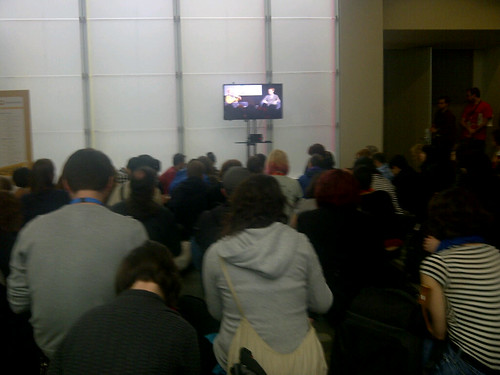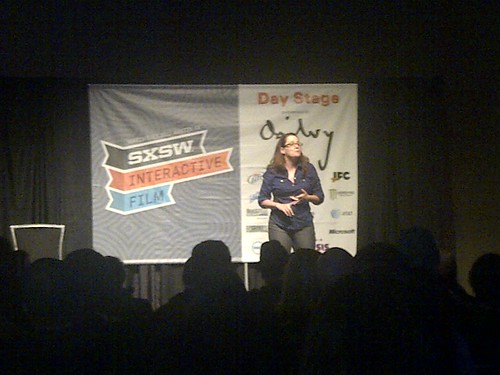 Today began with great anticipation and mild disappointment, with a bit of admiration of the inherent goodness of humanity thrown into the mix. Upon my arrival at the Convention Center this morning, I had hoped to attend “A Conversation with Joss Whedon” (#SXjosswhedon on Twitter), featuring the man himself. If you are unfamiliar with Joss Whedon, I first have to wonder how you even found this blog and why you’ve read this far. Joss Whedon is responsible for making “shiny” a culturally-relevant adjective. He brought us the long-running television classic (in some circles) “Buffy the Vampire Slayer” and the ahead-of-its-time science fiction western “Firefly.” He has perhaps the most devoted fan base in all of American entertainment, so I was quite excited.
Today began with great anticipation and mild disappointment, with a bit of admiration of the inherent goodness of humanity thrown into the mix. Upon my arrival at the Convention Center this morning, I had hoped to attend “A Conversation with Joss Whedon” (#SXjosswhedon on Twitter), featuring the man himself. If you are unfamiliar with Joss Whedon, I first have to wonder how you even found this blog and why you’ve read this far. Joss Whedon is responsible for making “shiny” a culturally-relevant adjective. He brought us the long-running television classic (in some circles) “Buffy the Vampire Slayer” and the ahead-of-its-time science fiction western “Firefly.” He has perhaps the most devoted fan base in all of American entertainment, so I was quite excited.
 But I got there too late.
But I got there too late.
Not actually late, mind you. His talk began at 11:00 a.m., and I arrived at the Convention Center at around 10:20 a.m. I stopped to buy coffee, which might have been my big mistake. By the time I made it to the fourth floor, where he would be talking in the imposingly-titled Room 18abcd, the line snaked back around on itself. At around 10:50, a SXSW volunteer inserted himself into the line, about forty people ahead of me, and announced that everyone standing behind him wasn’t going to get in.
So, like Malcolm Reynolds at Serenity Valley (seriously, you need to watch “Firefly”), I withdrew from the line and took a seat along the wall. A volunteer then informed us that a live feed of the talk would be available at a “hearable” volume. 11:00 arrived, and something remarkable happened. The throngs of people denied the opportunity to see Joss Whedon in the flesh sat down on the floor to watch the video screen, allowing everyone there a relatively unimpeded view.
Joss Whedon
 I tweeted a bit of what was discussed. As is common with filmmaker conversations at conferences, it was mostly thoughts on film, the creative process, and maddeningly vague hints and references to current and future projects.
I tweeted a bit of what was discussed. As is common with filmmaker conversations at conferences, it was mostly thoughts on film, the creative process, and maddeningly vague hints and references to current and future projects.
He mostly talked about “Cabin in the Woods,” a recent horror-esque project, with a bit of commentary on “The Avengers.” Of course, the question of when “Firefly” will be coming back was raised, to which Joss said he’s waiting for a call from a network and he is “not ruling it out.” I tweeted some of my favorite bits from his talk, which I now attempt to reproduce here:
- “My favorite thing is going into a movie not knowing what to expect.”
- He spoke very highly of Danny Boyle’s “Sunshine,” which is a good way to endear oneself to me.
- Of the “Evil Dead” films, he believes part 1 is “the real classic,” because it established the various tropes of the genre. Bold words, sir.
- He often prefers working with a lower budget. Budget restrictions, he says, make it easier for “things to feel lived in.”
- The genre of torture porn is not really horror, because it mostly consists of people the audience hates getting killed in inventive ways for about 90 minutes. In other words, it’s not actually scary.
- Numerous studio executives asked him if “Buffy the Vampire Slayer” was a working title. The network apparently wanted to change it to “Slayer” for years. I guess, had that happened, “Buffy” could have joined “and a Pizza Place.”
- “I dislike revision, and I’ll tell you why. It’s more work.”
- The first question from the audience was simply a request for a high-five. Joss gave the guy one. It was awesome.
- Best question from the audience: “Why do the networks keep fucking with you?”
- Joss’ answer to the best question, in brief: Networks have their own agenda and a business model to follow. Great content, by itself, will not sway them.
- “Dollhouse” was about sex on a fundamental level (duh.) The network apparently asked him to take out the sex and replace it with shooting.
That was pretty much it. Then they quickly cleared people off of the hallway floor so that the multitudes of people coming out of the presentation room wouldn’t trample them.
Weather
 It’s cold and rainy and generally nasty. I only mention that so I have an excuse to use this Willy Wonka meme picture.
It’s cold and rainy and generally nasty. I only mention that so I have an excuse to use this Willy Wonka meme picture.
Remixes
I wandered a bit and came back to the same room (after concluding it would take too long to stand in line for coffee or food) for a talk called “Everything is a Remix, so Steal Like an Artist” (#SXREMIX on Twitter) with Austin Kleon and Kirby Ferguson. I had not heard of either of these guys before, but the subject sounded interesting, and it was.
They said that their goal for the presentation was to “demystify creativity.” Kirby says that “all artists spend their formative years doing derivative work.” After copying for some time, we create art through transformation. Edison, as but one example, didn’t invent the light bulb. He improved on it & made it commercially viable.
They outlined the three basic elements of creativity: Copy, transform, combine.
If you only “combine” things, then you are not really putting your own voice into it. Kirby compares what that process creates to Frankenstein’s monster.
In a video presentation on influences in “Star Wars,” Kirby showed the influence of Joseph Campbell, Kurosawa, “The Searchers,” World War II films, and more.
“Creativity is not magic, Kirby says. Does it ruin “Star Wars” to see how much material George Lucas “stole?” In a sense, it may not make “Star Wars” itself more interesting, but it turns the film into a film history lesson.
“Nothing is completely original” – this just means we need to redefine “original.” “Original” could mean “new & exciting” as opposed to “unprecedented.”
“Halo effect” – people want to make something wholly new, but they shouldn’t have to. This could be viewed as empowering. Don’t worry too much about being derivative, just create.
Mythical idea of the “lone genius”: Film is a collaboration requiring collaboration. Terry Gilliam calls himself a filter for the ideas. God used to get all the credit for creativity. The Romantics (Lord Byron, et al) changed it to themselves alone, & we still have that idea. The lone genius idea tends to excuse bad behavior and frequently destroys young talent. It is more important, Austin said, to be a good human being than a good artist (Kirby sort of disagreed).
Most of us have no problem with copying as long as we’re the ones doing it.
On the difference between a “remix” and a “ripoff”: Remixes acknowledge the source material. Ripoffs pretend to be original. Austin says plagiarism and forgery are two sides of the same coin.
A final quote from Austin: “Imitation is only flattery if it’s any good.”
A Blogging Interlude
I had a bit of free time, so I headed back over to the Samsung Bloggers’ Lounge, where they unfortunately did not have any free food or coffee. Still, it offered a good, albeit crowded, place to sit down and write for a little while. It’s also a good place to strike up conversations with random people. Let me throw a little SEO love to the people I met today: there was a Chicago marketing consultant (Lon Taylor), a Los Angeles online live chat service provider (Ben Congleton), and a Houston mobile technology provider (the awesomely-named Paul Steel). I also finally got to meet Jen Wojcik in person. That was awesome. I forgot to mention that yesterday I finally met The Q in person too! It’s great to actually meet the Tweeters you follow.
Story Wars
Next up was “Winning the Story Wars” (@SXstorywars on Twitter), a reading by Jonah Sachs from his forthcoming book of the same name. It was very marketing-oriented, but offered some excellent pointers for storytelling in general, I think.
He first talked about how we began telling stories through oral tradition. This eventually led to the Broadcast Era, which in turn led to the “Digitoral” Era (don’t you just love marketing neologisms?)
There was discussion of Joseph Campbell, the second time I’d heard about him today! The ingredients of myth are explanation, meaning, story, and ritual. Religion, science, & entertainment can’t offer all four at the same time, but marketing can. (At this point I was a bit skeptical, but keep reading). He gave the example of the Marlboro Man: the Marlboro Man made it okay for men to smoke filtered cigarettes, which was an issue back in the day, and then became a major cultural icon. In other words, the myth and storytelling is not always a good thing for society, but I digress.
He then talked about the model of “freaks, cheats, and familiars,” and this was pretty interesting. People, by which he meant the human race, have existed in our current biological state for at least 70,000 years. Understanding how people thought 70,000 years ago, when times were presumably less complicated, helps us understand how people think today. Back then, people lived in small tribes, and they evolved to react to unfamiliar people, viewing them as either a threat or an opportunity. “Freaks” in a story grab people’s attention and draw them in.
Next, he addressed the “problem of altruism”: people have to both compete and cooperate to survive. Stories of “cheats” uphold cultural norms, because people want to see them punished. “Cheats” could also be used in a story to defy a cultural norm we hate.
As for “familiars,” stories are told in “tribes” that the marketer can’t control, so the story is encoded in a language or setting the audience will accept. This is sort of like the “everyman” character.
Then he read a story about Robert Oppenheimer and the Trinity test, which was interesting. That’s all I have in my notes.
A Carlin Home Companion
 I stuck around in the same room because I was intrigued by the next presentation. Kelly Carlin, daughter of George Carlin, presented a one-woman show about her father, “A Carlin Home Companion” (#SXcarlin on Twitter). It was amazing. George Carlin, in my humble opinion, was and remains one of the greatest comics of our era, and he was simply a great wit and intellect to boot. She tells a deeply personal and moving story of growing up in his home, watching the course of his career, from standard “Tonight Show” comic, to countercultural icon, to drug addict, to stand-up hero, and more. It is too personal a story for me to possibly do it justice as a summary here. I’ll leave it at a paraphrase of how she ended the show, saying of her father:
I stuck around in the same room because I was intrigued by the next presentation. Kelly Carlin, daughter of George Carlin, presented a one-woman show about her father, “A Carlin Home Companion” (#SXcarlin on Twitter). It was amazing. George Carlin, in my humble opinion, was and remains one of the greatest comics of our era, and he was simply a great wit and intellect to boot. She tells a deeply personal and moving story of growing up in his home, watching the course of his career, from standard “Tonight Show” comic, to countercultural icon, to drug addict, to stand-up hero, and more. It is too personal a story for me to possibly do it justice as a summary here. I’ll leave it at a paraphrase of how she ended the show, saying of her father:
He had to give up who he thought he was supposed to be to become who he was meant to be.
Photo credits: ‘Madness!’ by imtheq on instagram; ‘Everything at SXSW involves waiting in line’, ‘Joss Whedon speaks! (via live feed)’, and ‘Kelly Carlin in “A Carlin Home Companion”‘ by wondermutt, on Flickr; Willy Wonka meme obtained here.






